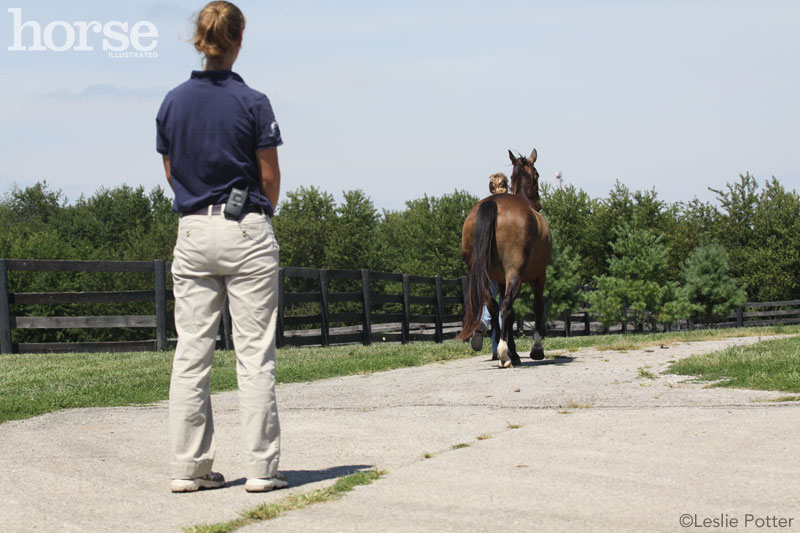As your horse trots out to pasture to catch up with his equine buddies, you notice something not quite right with how he is moving. It’s hard to put your finger on it, but you are sure you hadn’t noticed his peculiar trot before. Your mind is spinning as you grab a halter and head out to retrieve him so you can take a closer look.
Where to Start
It may not be as important to define which leg is lame as it is to determine if there is a problem that would prompt you to call your vet.
Which Leg is Lame?
The trick to determining which leg is lame is to look at the overall picture of your horse’s movement. It helps to do this periodically when he is sound so you have a visual memory to compare to when there is a problem. Identification of lameness takes practice, and the more horses you watch, the better you’ll get.
Do the shoulders swing evenly as he trots? Is the pelvic swing consistent and fluid from side to side? Or, is there a shortening of his stride and/or a noticeable head bob?
On a straight line, watch him trot toward and away from you. His forelimb strides should look even when trotting toward you. If he ducks his head or is obviously limping, then there is clearly a problem. Typically, a horse will raise his head and shoulder when the lame front leg strikes the ground.
From behind, do both hips rise evenly to the same height? If not, then typically the hip of the lame leg will rise up higher (hip hike) as he tries to unload it more quickly. There are exceptions to every rule when it comes to lameness, but these general tendencies give you a starting point for evaluation.
What Causes Lameness?
Lameness comes in all forms, from acute (sudden and severe) onset to slowly progressing and chronic. Abrupt injuries can happen when a horse simply takes a bad step or slips on wet ground, or from a traumatic blow from another horse’s kick. Such injuries are often related to soft tissue strain of a ligament or tendon, bruising of deep tissue or bone, or a
laceration.
Hoof bruising or a hoof abscess often causes acute-onset lameness; in some cases, a horse may appear to have a fracture, failing to put any weight on a throbbing foot. Laminitis is also quite evident, as a horse stands with his front feet camped out, often shifting weight from foot to foot. When asked to turn, a laminitic horse is reluctant to do so and turns with
great difficulty.
More insidious problems develop due to degenerative joint disease, or osteoarthritis. Lameness in these cases tends to come on slowly, perhaps escaping your notice until the disease progression reaches the point of significantly painful joint degeneration. To improve your horse’s outcome, it is always best to identify such problems early—this maximizes the
available therapeutic options.

When to Call Your Vet
The best approach to managing any lameness in your horse is to include your veterinarian immediately. Early identification of a problem helps to avert a more serious progression of an injury. It is best not to waste time troubleshooting for a variety of possibilities or to mask a significant problem with anti-inflammatory medications. Instead, your knowledgeable vet can zero in on the location of the injury by performing a thorough clinical exam with useful diagnostic tools, like flexion tests, hoof testers, nerve blocks, and radiographs (x-rays) or ultrasound.
Once an accurate diagnosis is achieved, appropriate remedies can be implemented. A team effort with your veterinarian quickly gets your horse on the road to recovery, and you back in the saddle.
Further Reading
Inside a Lameness Exam
Pre-Purchase Exam: Better Quality Assurance






Great advice.
Good advice. Treating my 14-yo’s first hoof abscess this year, wanted to read up more to brush up on my knowledge. He’s had a couple of good “twist” injuries in the past due to his excitable nature and high spirits, an accident with a barn manager and an icy stall that led to surgery on a back heel bulb/hoof, “appaloosa” feet, and a bad farrier trim that I’ve all had to treat and learn about as I went along. I’m also working on equine massage, and seeing how gentle stretching before and after lunging and a ride can improve a horse’s mobility. Many thanks for this class; it’ll keep me up to date.
good info and advice
so helpful
This is such a great article! Thank you 🙂
I was reading about a girth and girth sleeve that is supposed to help you detect lameness in your horse immediately? They’re on Kickstarter at the moment: https://www.kickstarter.com/projects/447570149/seaver-the-first-connected-equipment-for-horses
Has any one else heard of this? Does anybody know any other products that can help detect lameness as soon as it occurs?